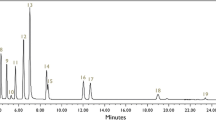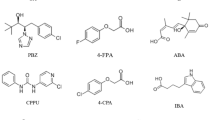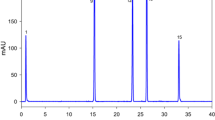Abstract
Analysis of organic acids has become increasingly important due to their role in the physiological activity of plants, and many separation methods have been developed for the simultaneous determination of these compounds in plant samples. Herein, ultra fast liquid chromatography and photodiode array detection (UFLC-PDA) was applied to the analysis of organic acids in young shoots, leaves, aerial parts and flowering shoots, as well as in flowers and fruits, of 35 plant species, according to their traditional use. The studied plants were divided in three groups: traditionally cultivated food plants, wild edible plants and wild medicinal plants. Most of the species were characterized for the first time. Among all the analysed species, Rumex acetosella leaves and aerial parts revealed the highest content of total organic acids. Overall, the organic acids found in the studied plant species make them suitable to be used as food additives such as antioxidants (e.g. ascorbic acid) or acidulants (e.g. citric and malic acids).

Similar content being viewed by others
References
Adams MA, Chen ZL, Landman P, Colmer TD (1999) Simultaneous determination by capillary gas chromatography of organic acids, sugars, and sugar alcohols in plant tissue extracts as their trimethylsilyl derivatives. Anal Biochem 266:77–84
Anastassiadis S, Morgunov IG, Kamzolova SV, Finogenova TV (2008) Citric acid production patent review. Recent Pat Biotechnol 2:107–123
Barros L, Heleno SA, Carvalho AM, Ferreira ICFR (2009) Systematic evaluation of the antioxidant potential of different parts of Foeniculum vulgare Mill. from Portugal. Food Chem Toxicol 47:2458–2464
Barros L, Carvalho AM, Morais JS, Ferreira ICFR (2010a) Strawberry-tree, blackthorn and rose fruits: Detailed characterization in nutrients and phytochemicals with antioxidant properties. Food Chem 120:247–254
Barros L, Oliveira S, Carvalho AM, Ferreira ICFR (2010b) In vitro antioxidant properties and characterization in nutrients and phytochemicals of six medicinal plants from the Portuguese folk medicine. Ind Crops Prod 32:572–579
Barros L, Heleno SA, Carvalho AM, Ferreira ICFR (2010c) Lamiaceae often used in Portuguese folk medicine as a source of powerful antioxidants: Vitamins and phenolics. LWT - Food Sci Tech 43:544–550
Barros L, Carvalho AM, Ferreira ICFR (2010d) Leaves, flowers, immature fruits and leafy flowered stems of Malva sylvestris: A comparative study of the nutraceutical potential and composition. Food Chem Toxicol 48:1466–1472
Barros L, Carvalho AM, Ferreira ICFR (2011a) Comparing the Composition and Bioactivity of Crataegus Monogyna Flowers and Fruits used in Folk Medicine. Phytochem Anal 22:181–188
Barros L, Cabrita L, Vilas-Boas M, Carvalho AM, Ferreira ICFR (2011b) Chemical, biochemical and electrochemical assays to evaluate phytochemicals and antioxidant activity of wild plants. Food Chem 127:1600–1608
Barros L, Carvalho AM, Ferreira ICFR (2011c) Exotic fruits as a source of important phytochemicals: Improving the traditional use of Rosa canina fruits in Portugal. Food Res Inter 44:2233–2236
Barros L, Pereira C, Ferreira ICFR (2012) Optimized analysis of organic acids in edible mushrooms from Portugal by ultra fast liquid chromatography and photodiode array detection. Food Anal Method. doi:10.1007/s12161-012-9443-1
Batista C, Barros L, Carvalho AM, Ferreira ICFR (2011) Nutritional and nutraceutical potential of rape (Brassica napus L. var. napus) and “tronchuda” cabbage (Brassica oleraceae L. var. costata) inflorescences. Food Chem Toxicol 49:1208–1214
Bennet-Clark TA (1993) The role of the organic acids in plant metabolism. Part I. New Phytol 32:37
Bozan B, Sagdullaev BT, Kzar M, Aripov KN, Baser KHC (1998) Comparison of ascorbic and citric acid contents in Rosa canina L. fruit growing in the central Asian region. Chem Nat Comp 34:687–689
Cruz-Rus E, Amaya I, Valpuesta V (2012) The challenge of increasing vitamin C content in plant foods. Biotechnol J 7:1110–1121
Ferreres F, Fernandes F, Sousa C, Valentão P, Pereira JA, Andrade PB (2009) Metabolic and bioactivity insights into Brassica oleracea var. acephala. J Agric Food Chem 57:8884–8892
Gabriel J, Kesselmeier (1999) Apoplastic solute concentrations of organic acids and mineral nutrients in the leaves of several Fagaceae. Plant Cell Physiol 40:604–612
Gebre GM, Kuhns MR, Brandle JR (1994) Organic solute accumulation and dehydration tolerance in three water-stresses Populus deltoids clones. Tree Physiol 14:575–587
Guerra L, Pereira C, Andrade PB, Rodrigues MA, Ferreres F, Pinho PG, Seabra RM, Valentão P (2008) Targeted metabolite analysis and antioxidante potential of Rumex induratus. J Agric Food Chem 56:8184–8194
Guimarães R, Barros L, Carvalho A, Ferreira ICFR (2010) Studies on chemical constituents and bioactivity of Rosa micrantha: an alternative antioxidants source for food, pharmaceutical, or cosmetic applications. J Agric Food Chem 58:6277–6284
Karovicová J, Polonsky J, Príbela A (1990) Composition of organic acids of Sambucus nigra and Sambucus ebulus. Nahrung 34:665–667
Martins D, Barros L, Carvalho AM, Ferreira ICFR (2011) Nutritional and in vitro antioxidant properties of edible wild greens in Iberian Peninsula traditional diet. Food Chem 125:488–494
Mucha AP, Almeida CMR, Bordalo AA, Vasconcelos MTSD (2005) Exudation of organic acids by a marsh plant and implications on trace metal availability in the rhizosphere of estuarine sediments. Est Coast Shelf Sci 65:191–198
Özcan T (2008) Some vitamin and organic acid contents in the fruits of Prunus spinosa L. subsp. Dasyphulla (Schur) domin from Europe-in-Turkey. IUFS J Biol 67:105–114
Pereira C, Barros L, Carvalho AM, Ferreira ICFR (2011) Nutritional composition and bioactive properties of commonly consumed wild greens: Potential sources for new trends in modern diets. Food Res Inter 44:2634–2640
Pinela J, Barros L, Carvalho AM, Ferreira ICFR (2011) Influence of the drying method in the antioxidant potential and chemical composition of four shrubby flowering plants from the tribe Genisteae (Fabaceae). Food Chem Toxicol 49:2983–2989
Pinela J, Barros L, Carvalho AM, Ferreira ICFR (2012a) Nutritional composition and antioxidant activity of four tomato (Lycopersicon esculentum L.) farmer’ varieties in Northeastern Portugal homegardens. Food Chem Toxicol 50:829–834
Pinela J, Barros L, Dueñas M, Carvalho AM, Santos-Buelga C, Ferreira ICFR (2012b) Antioxidant activity, ascorbic acid, phenolic compounds and sugars of wild and commercial Tuberaria lignosa samples: Effects of drying and oral preparation methods. Food Chem 135:1028–1035
Qiu J, Jin X (2002) Development and optimization of organic acid analysis in tobacco with ion chromatography and suppressed conductivity detection. J Chromatogr A 950:81–88
Ribeiro B, Andrade PB, Baptista P, Barros L, Ferreira ICFR, Seabra RM, Valentão P (2008) Leucopaxillus giganteus mycelium: effect of nitrogen source on organic acids and alkaloids. J Agric Food Chem 56:4769–4774
Rivasseau C, Boisson A-M, Mongélard G, Couram G, Bastien O, Bligny R (2006) Rapid analysis of organic acids in plant extracts by capillary electrophoresis with indirect UV detection. directed metabolic analyses during metal stress. J Chromatogr A 129:283–290
Ruiz-Rodríguez B-M, Morales P, Fernández-Ruiz V, Sánchez-Mata M-C, Cámara M, Díez-Marqués C, Pardo-de-Santayana MM, Tardio J (2011) Valorization of wild strawberry-tree fruits (Arbutus unedo L.) though nutritional assessment and natural production data. Food Res Int 44:1244–1253
Sánchez-Mata MC, Loera RDC, Morales P, Fernández-Ruiz V, Cámara C, Marqués D, Pardo-de-Santayana M, Tardio J (2012) Wild vegetables of the Mediterranean area as valuable sources of bioactive compounds. Genet Resour Crop Evol 59:431–443
Scherer R, Rybca ACP, Ballus CA, Meinhart AD, Filho JT, Godoy HT (2012) Validation of a HPLC method for simultaneous determination of main organic acids in fruits and juices. Food Chem 135:150–154
Suaréz MH, Rodríguez ER, Romero CD (2008) Analysis of organic acid content in cultivars of tomato harvested in Tenerife. Eur Food Res Technol 226:423–435
Vaughan JG, Geissler CA (1997) The New Oxford Book of Food Plants. Oxford University Press, New York, p 196
Veberic R, Jakopic J, Stampar F, Schmitzer V (2009) European elderberry (Sambucus nigra L.) rich in sugars, organic acids, anthocyanins and selected polyphenols. Food Chem 114:511–515
Wang M, Qu F, Shan X-Q, Lin J-M (2003) Development and optimization of a method for the analysis of low-molecular-mass organic acids in plants by capillary electrophoresis with indirect UV detection. J Chromatogr 989:285–292
Acknowledgements
The authors are grateful to Fundação para a Ciência e a Tecnologia (FCT, Portugal) and COMPETE/QREN/EU for financial support to CIMO (strategic project PEst-OE/AGR/UI0690/2011). L. Barros also thanks to FCT, POPH-QREN and FSE for her grant (SFRH/BPD/4609/2008).
Author information
Authors and Affiliations
Corresponding author
Additional information
Both authors contributed equally in this work.
Rights and permissions
About this article
Cite this article
Pereira, C., Barros, L., Carvalho, A.M. et al. Use of UFLC-PDA for the Analysis of Organic Acids in Thirty-Five Species of Food and Medicinal Plants. Food Anal. Methods 6, 1337–1344 (2013). https://doi.org/10.1007/s12161-012-9548-6
Received:
Accepted:
Published:
Issue Date:
DOI: https://doi.org/10.1007/s12161-012-9548-6




